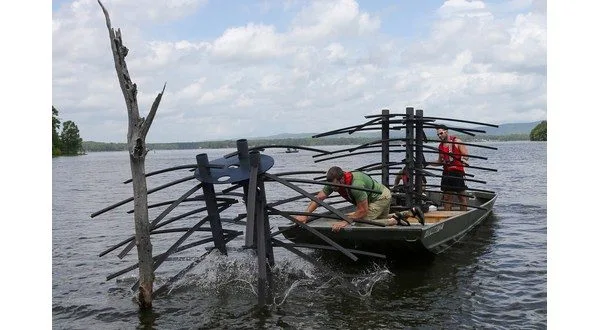
As summer temperatures push fish to deeper, cooler waters, the Arkansas Game and Fish Commission (AGFC) is helping anglers stay on the bite with an interactive map of fish attractor locations across the state.AGFC Fisheries Biologist Sean Lusk said the agency and volunteers placed attractors at more than 270 sites across 29 Arkansas lakes last year, with the total number of structures likely reaching into the thousands.
“These structures range from a couple of Christmas trees to larger cedar trees pulled from shorelines, or artificial designs made from PVC and other durable, water-safe materials,” Lusk said.
Most attractors are placed in locations where fish are already likely to congregate, typically deeper than 10 feet- especially in U.S. Army Corps of Engineers reservoirs. Lusk emphasized that care is taken to avoid creating boating hazards and that large cedar trees remain among the most effective natural options in their first year of placement.
The AGFC’s interactive fish attractor map, available at agfc.com/maps, allows anglers to search by lake and click on blue square icons to view details, including the attractor’s material type, installation year, and GPS coordinates.
Lusk recommends targeting attractors made of natural materials that are less than four years old. “Artificial structures last longer, but natural ones tend to produce more fish early on,” he said.
John Duncan, a fishing guide on DeGray Lake, said crappie respond to both natural and artificial attractors, but anglers should watch for patterns in how fish relate to different types of cover.
During the summer, fish often gather just above the thermocline – the point in the water column where warm surface water meets colder, oxygen-rich water below. This zone is usually at least 15 feet deep and can be spotted on sonar by increased screen clutter at that depth.
To fish these attractors, Duncan advises using marker buoys to identify brush piles, then fishing with simple gear like slip bobbers and minnows. “It’s a basic technique that works for anglers of all skill levels,” he said. “For more advanced anglers, casting jigs past the attractor and retrieving slowly can also be effective.”
For more information or to download attractor files compatible with GPS units, visit agfc.com/fishattractors.
WebReadyTM Powered by WireReady® NSI










